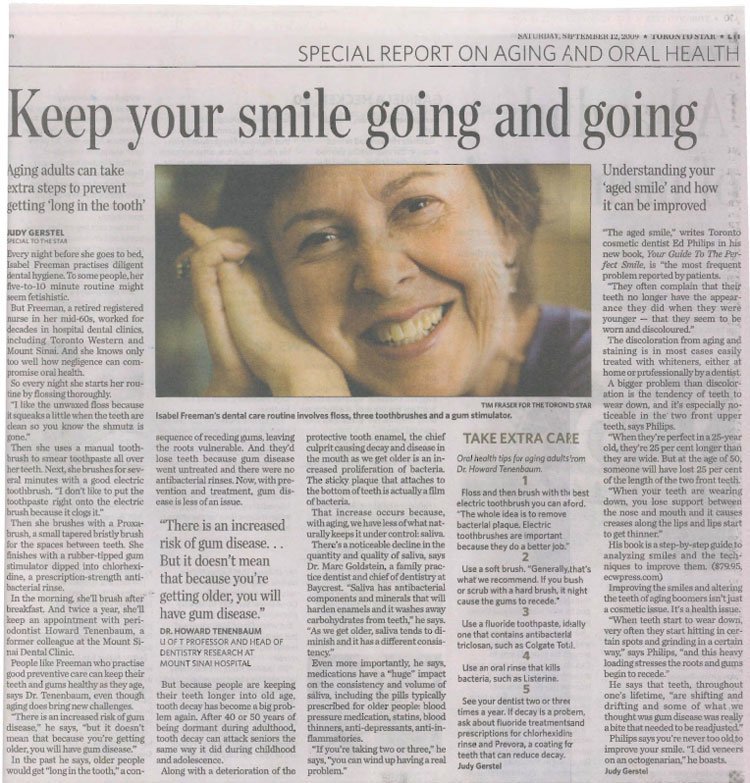Keep your smile going and going

By Judy Gerstel
“The aged smile,” writes Toronto cosmetic dentist Ed Philips in his new book, Your Guide To The Perfect Smile, is “the most frequent problem reported by patients.”
“They often complain that their teeth no longer have the appearance they did when they were younger – that they seem to be worn and discoloured”
The discoloration from aging and staining is in most cases easily treated with whiteners, either at home or professionally by a dentist.
A bigger problem than discoloration is the tendency of teeth to wear down, and it’s especially noticeable in the two front upper teeth, says Philips.
“When they’re perfect in a 25-year old. they’re 25 per cent longer than they are wide. But at the age of 50, someone will have lost 25 per cent of the length of the two front teeth.”
“When your teeth are wearing down, you lose support between the nose and mouth and it causes creases along the lips and lips start to get thinner.”
His book is a step-by-step guide,to analyzing smiles and the techniques to improve them. ($79.95, ecwpress.com)
Improving the smiles and altering the teeth of aging boomers isn’t just a cosmetic issue. If s a health issue.
“When teeth start to wear down, very often they start hitting in certain spots and grinding in a certain way,” says Philips, “and this heavy loading stresses the roots and gums begin to recede.”
He says that teeth, throughout one’s lifetime, “are shifting and drifting and some of what we thought was gum disease was really a bite that needed to be readjusted.”
Philips says you’re never too old to improve your smile. “I did veneers on an octogenarian,” he boasts.
Aging adults can take extra steps to prevent getting ‘long in the tooth’
sabel Freeman practises diligent dental hygiene. To some people, her five-to-10 minute routine might seem fetishistic.
But Freeman, a retired registered nurse in her mid-60s, worked for decades in hospital dental clinics, including Toronto Western and Mount Sinai. And she knows only too well how negligence can comromise oral health.
So every night she starts her routine by flossing thoroughly.
“I like the unwaxed floss because it squeaks a little when the teeth are clean so you know the shmutz is gone.
Then she uses a manual toothbrush to smear toothpaste all over her teeth. Next, she brushes for several minutes with a good electric toothbrush. “I don’t like to put the toothpaste right onto the electric brush because it clogs it.”
Then she brushes with a Proxabrush, a small tapered bristly brush for the spaces between teeth. She finishes with a rubber-tipped gum stimulator dipped into chlorhexidine, a prescription-strength antibacterial rinse.
In the morning, she’ll brush after breakfast. And twice a year, she’ll keep an appointment with periodontist Howard Tenenbaum, a former colleague at the Mount Sinai Dental Clinic.
People like Freeman who practise good preventive care can keep their teeth and gums healthy as they age, says Dr. Tenenbaum, even though aging does bring new challenges.
“There is an increased risk of gum disease,” he says, “but it doesn’t mean that because you’re getting older, you will have gum disease.”
In the past he says, older people would get “long in the tooth,” a consequence of receding gums, leaving the roots vulnerable. And they’d lose teeth because gum disease went untreated and there were no antibacterial rinses. Now, with prevention and treatment, gum disease is less of an issue.
But because people are keeping their teeth longer into old age, tooth decay has become a big problem again. After 40 or 50 years of being dormant during adulthood, tooth decay can attack seniors the same way it did during childhood and adolescence.
Along with a deterioration of the protective tooth enamel, the chief culprit causing decay and disease in the mouth as we get older is an increased proliferation of bacteria. The sticky plaque that attaches to the bottom of teeth is actually a film of bacteria
That increase occurs because, with aging, we have less of what naturally keeps it under control: saliva. There’s a noticeable decline in the quantity and quality of saliva, says Dr. Marc Goldstein, a family practice dentist and chief of dentistry at Baycrest. “Saliva has antibacterial components and minerals that will harden enamels and it washes away carbohydrates from teeth,” he says. “As we get older, saliva tends to diminish and it has a different consistency!”
Even more importantly, he says, medications have a “huge” impact on the consistency and volume of saliva, including the pills typically prescribed for older people: blood pressure medication, statins, blood thinners, anti-depressants, anti-inflammatories.
“If you’re taking two or three:’ he says, “you can wind up having a real problem.”
TAKE EXTRA CARE
- Oral health tips for aging adults from Dr. Howard Tenenbaum.
- Floss and then brush with the best electric toothbrush you can afford. “The whole idea is to remove bacterial plaque. Electric toothbrushes are important because they do a better job.”
- Use a soft brush. “Generally, that’s what we recommend. If you brush or scrub with a hard brush, it might cause the gums to recede.”
- Use a fluoride toothpaste, ideally one that contains antibacterial triclosan, such as Colgate Total.
- Use an oral rinse that kills bacteria, such as Listerine.
- See your dentist two or three times a year. If decay is a problem, ask about fluoride treatments and prescriptions for chlorhexidine rinse and Prevora, a coating for teeth that can reduce decay.

